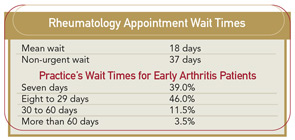
This is part two of a four-part series on the 2006 Rheumatology Workforce Study.
In 2005, when the ACR commissioned its first workforce study in 10 years, it suspected—correctly—that the demand for rheumatology services would increasingly exceed supply over the next several years. In fact, rheumatologists are keenly aware that patients are already waiting longer to see a specialist. “The problem is not specific to rheumatology; it really involves all healthcare delivery in this country,” says Timothy Harrington, Jr., MD, head of the rheumatology section at the University of Wisconsin in Madison.
Dr. Harrington was a member of the ACR group that spearheaded the workforce study effort, and he has spent the past 10 years redesigning his own rheumatology practice to reduce wait times and deliver higher quality patient care.
The workforce study report suggests practice redesign—for example, implementing patient screening and employing advanced practice nurses and physicians assistants (PAs)—is one way to minimize the effects of the workforce shortage.
“The question that we all must answer is how many rheumatologists are really needed for people with rheumatology disease,” Dr. Harrington says. “We have not defined ‘necessary care’ and the result is a high level of inefficiency.”
Practice Efficiency
The workforce study highlights wait times for patients as a strong indication of excess demand. The current wait time for new rheumatology patients is higher than for general medicine and other specialty referrals, such as cardiology and gastroenterology.
The workforce report notes rheumatologists try their best to see early arthritis patients quickly in order to prevent joint damage, although some practices still have wait times over two months for these patients.
Nearly all (97%) of the rheumatology practices that responded to a survey conducted as part of the workforce study report that they accept new patients. However, nearly half (48%) restrict access by requiring a referral from a primary care physician. Despite this requirement, Dr. Harrington emphasizes that approximately half of all new patients to rheumatology practices show up without medical records and a majority (80%) do not come to the specialist with a written referral. This automatically triggers the need for a follow-up appointment, he says.
“That almost half of rheumatologists report limiting access based on referral and almost half report wait times for non-urgent patients exceeding four weeks suggests that there is considerable excess demand for rheumatology services,” notes the rheumatology survey final report. “The current supply of rheumatologist visits is not equal to the demand for those visits such that rheumatologists are limiting access through requiring referrals or having long wait times for appointments.”

